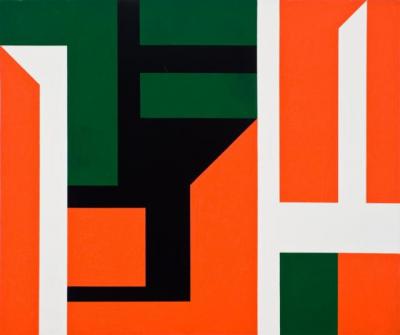Mary Henry: art ltd artist appreciation

"Mary Henry: The Last Constructivist"
Considering she spent over half her life in California as an art student,
muralist and exhibiting painter, it is dumbfounding that Mary Henry (who
died at 96 in Freeland, Washington this past summer) has received only
one retrospective in her native state, at the Los Altos Hills City Hall in
1988. But then, moving to Washington State in 1976 at age 63, she
may have produced her greatest work away from California, from which
she fled after the accidental death of her son, William. Perfectly
composed geometric abstractions whose colors refer to weather,
nature and landscaped gardens, Henry’s paintings are based on
meticulous colored-pencil drawings. Plan replaces impulse; design
becomes exalted to a state of emotional aspiration, always held in
check by line and areas of flat solid color. Often nearly 20 feet wide,
they embrace the viewer.
Henry settled first in Everett, WA and then on a small estate on
Whidbey Island near Freeland. There she began a European-style
formal garden in 1980, designed and built a studio, and began to create
a series of huge, colorful abstract paintings. Long before that, Mary
Marguerite Dill was the fourth of six children raised by an unsuccessful
quicksilver miner in Middletown, California. Her undergraduate work at
California College of Arts and Crafts (BFA, 1938) ended at the height of
the Depression. After two years on the Federal Art Project, she got a
teaching job at Iowa State University but returned to study lithography
at the San Francisco Art Institute with Ray Bertrand.
World War II defense work doing engineering drawings at a new firm,
Hewlett-Packard (both of whom became good friends), was followed by
study with László and Sibyl Moholy-Nagy at the transplanted Bauhaus,
Institute of Design (ID), Chicago. Although the former excused her from
some introductory courses and took a special interest in her progress,
even offering her a teaching job upon graduation (MA, 1946), Henry had
to turn it down to accompany her husband to Arkansas where he was
studying malaria control. “They were the worst years of my life,” she
later commented on the time in Bauxite, Arkansas.
ID created Mary Henry, non-objective artist and newborn American
Constructivist; system, plan, line, structure, form and color became
her abiding principles. “I wanted to get everything out of this school,
with precious little time,” she remembered. (Years later, she was
re-introduced to Chicago at Aaron Galleries). Between 1955 and 1962,
running a small interior design firm, Architectural Arts, with a friend,
Henry designed and created mosaics and murals for the bar at Sir
Francis Drake Hotel, the restaurant at The Emporium in Union Square,
Hewlett-Packard’s new cafeteria, and elsewhere. The murals led her to
resume painting, especially after her 1964 divorce and move to a
Victorian house in Mendocino where she spent the next decade. Her
San Francisco solo debut at Arleigh Gallery was warmly reviewed in the
October 1969 issue of a new magazine, Artforum. (She had already
shown in New York at ACA in 1943). Combining her industrial design
drafting background with the experience of architectural murals, she
blended her American Bauhaus art training into canvases with open
expanses of contained, bright and flat color. (One retrospective
concentrated only on her works on paper.)
Adding bright acrylic colors to her bold diptychs and triptychs, Henry
also faced down Minimalism with her North Slope series (1974-77),
20-foot-wide gray-on-gray diptychs (shown at Wright Exhibition Space
in 2007), but these were an anomaly in her otherwise sunny palette.
Henry’s elevation to membership in the venerable New York-based
group, American Abstract Artists, in 1992 led to important group shows
in Argentina, Israel, and Portugal as well as a return to New York. Her
works held their own next to Richard Anuskiewicz, Ibram Lassaw,
Clement Meadmore and Merrill Wagner. She received a $25,000
Flintridge Foundation Award in 2001.
Regional art critics, dealers and museum curators acknowledged her
impeccable, if displaced, lineage within European modernism and
ultimate status as the last American Constructivist. Before she made
her Seattle debut at Gallery Diane Gilson in 1980, she was taken up by
a group of artists (Lois Graham, Arlene O. Lev, Joan Stuart Ross and Kay
Rood) who met her at a Jack Tworkov workshop (He asked Henry,
“What are you doing here? You obviously don’t need it.”).
She received seven retrospectives during her lifetime at local art
museums, galleries and arts festivals between 1985 and 2007.
Although archival research has revealed diaries from the Mendocino
years, Henry did not write a lot, preferring to let her work speak.
However, she made one comment that merits attention: “If I could
physically manage to paint even larger paintings, I’m certain that I
should. I want my work to overpower me, to be more dominating than
I am, to have a life of its own so that when one of my paintings goes
out into the world, it can establish itself with no further help from me.”
That this occurred is part of the considerable, lengthy accomplishment
of her life and career, split between San Francisco and the Seattle area.
A small memorial exhibition with documentary photographs, plans
and catalogues was held in September 2009 at Howard House
Contemporary Art in Seattle with a more comprehensive survey
planned by the gallery for later this year.
––MATTHEW KANGAS